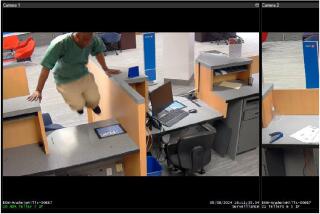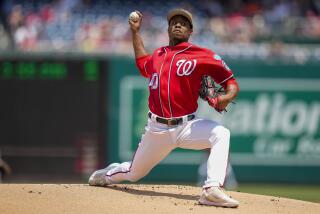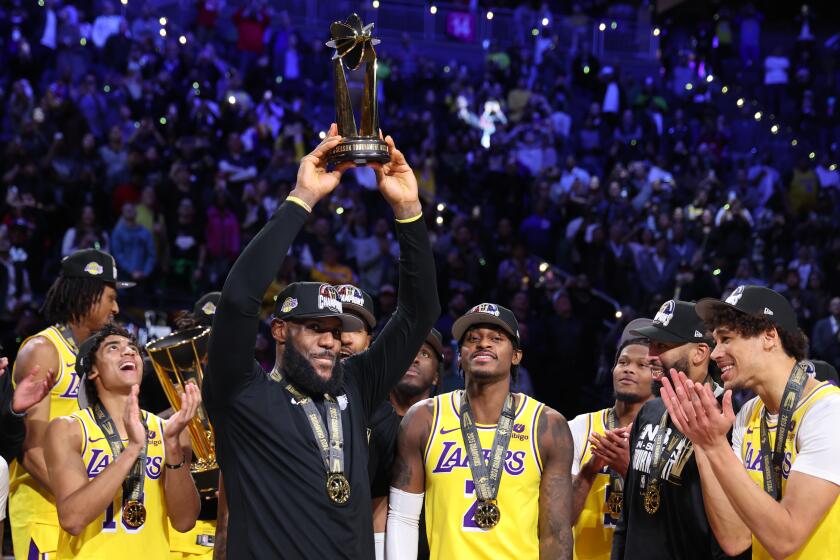NBA Finds It Hard to Get Gray Out : Survivor: Despite fight with Lakers, the Charlotte Hornets’ reserve from Kennedy High is no brawler. But a controversial career at UCLA and six seasons in the NBA have toughened Gray and enabled him to become an effective role player.
Stuart Gray left UCLA after his junior year with the idea of making an impact in the NBA, but his encounter with the Lakers last month wasn’t exactly what he had in mind.
Gray, a reserve center for the Charlotte Hornets, took on Lakers right and left--with rights and lefts. He scuffled with James Worthy, Michael Cooper, Vlade Divac, Byron Scott, and Mychal Thompson, and he even tangled with Coach Pat Riley in a flurry of fury.
For those who remember him from his high school days, Gray’s outburst was difficult to believe.
This, after all, wasn’t Maurice Lucas or Darryl Dawkins taking on all comers.
This was the same Stuart Gray, who, as a 7-foot gentle giant at Kennedy High, averaged 31 points and 17 rebounds in a 1980-81 All-American season.
This was the same Stuart Gray who saw the cheers turn to jeers during a respectable, but much-criticized, three-year career at UCLA where his aggressiveness and ability often were questioned.
Gray admits that he went too far against the Lakers. Brawling is not Gray’s way. In his sixth year in the NBA, Gray has become an effective role player by stalking rebounds, not opponents.
Yet, when push came to shove against the Lakers . . .
“I fouled (Worthy) too hard,” Gray says, “but it should have been just between the two of us. I pushed him and he pushed me and it just escalated. I started to get pushed by other players and I got a little mad.
“My boiling temperature takes a lot to get to, but I reached it. In retrospect, it’s not the best way to express yourself, especially for young kids looking for role models. I’ll be living this one down whenever I go talk to kids. But we’re humans and make mistakes and I have to try not to make the same mistake.”
The Lakers responded after the game at the Charlotte Coliseum with strong words. Riley, for instance, said, “I’ve seen one or two guys go crazy like that--I’ve seen Michael Cooper go that crazy. I don’t know what Stuart was thinking, but he was out of line. What he did was unconscionable.”
Gray, who will be in L. A. on Jan. 16 when the Clippers play host to the Hornets, was fined $5,000 and suspended for one game. Scott was fined $2,000, Cooper $1,000 and Worthy $500.
Hornet Coach Dick Harter, however, dismisses the fight as nothing more than life in the NBA, where only the strong survive.
“He’ll stand up and fight and he’s done that in the past, and I like that about him,” Harter says. “I don’t think he should back down (when provoked), and there’s nothing to feel bad about or apologize about.”
Gray says he harbors no ill feelings toward the Lakers, and hopes there’s no bad blood when the teams play twice more in March.
“They still boo me (in Los Angeles), probably because they remember UCLA,” Gray jokes. “Now it’ll be something else to boo about.”
At 245 pounds, Gray has the bulk to play like The Hulk. His style became more physical when he played for the Indiana Pacers his first four seasons in the NBA and was tutored by assistant Coach Mel Daniels, who set numerous Pacer rebounding records. Daniels counseled Gray to stand up to the Moses Malones and Karl Malones or get out of the way--on the bench.
“In the pros, it’s a lot different game,” says Gray, who was dubbed “Tex Cobb” by his teammates after the Laker confrontation. “There’s a lot of contact, a lot of tempers. I was taught by Mel Daniels that you don’t take it, but you have to stick up for yourself or you’ll end up face down flat.”
This season, Gray’s scoring (2.9) and rebounding (3.2) averages are up slightly compared to his career figures of 2.4 points and 2.7 rebounds. The Hornets have yet to rise, however, struggling to stay out of last place in the Midwest Division of the Western Conference.
Two weeks ago in a 107-82 loss to the San Antonio Spurs, Gray grabbed a season-high 10 rebounds and scored six points in 22 minutes. No other Hornet had more than five rebounds. But evidence of Gray’s inconsistency came two days later, when he had only two points and no rebounds in 12 minutes in the Hornets’ 94-92 win over the Cleveland Cavaliers.
“I really like Stuart,” Harter says. “I think he needs confidence and (more) minutes to go to a new level, but it’s tough in a losing situation to get the minutes spread around.”
Last season Gray averaged 2.6 points and 3.4 rebounds for the Pacers. The Hornets, an expansion team in their second season, traded Dyron Nix to the Pacers to obtain Gray, who was reunited with Harter, a former Pacer assistant who had pushed hard to acquire Gray.
“Things are great,” says Gray, who was married in July and is moving into a house 10 minutes from the Charlotte Coliseum. “I left UCLA and everyone thought I’d be out (of the NBA) in two days, and six years later, things are going well.”
Gray started all three of his years at UCLA and improved his scoring and rebounding averages each season, but he never could satisfy hard-to-please Bruin supporters who had heard that Gray was another Kareem Abdul-Jabbar or Bill Walton in the making.
He averaged 9.9 points and 7.9 rebounds his junior season, then bolted for the NBA in 1984 when he was selected in the second round by the Pacers, the 29th overall pick.
Gray says he would like to play 10 or 11 years in the NBA.
“That’s my minimum goal,” says Gray, who is averaging 12 minutes a game for the Hornets. “It shouldn’t be too hard if I keep improving. There’s a need for a player like me. That’s why I’ve stayed for six years.”
One of Gray’s biggest boosters is his former coach at Kennedy, Dean Cadwell, who provided the inspiration and fundamentals necessary for Gray to win the most valuable player award in basketball at the 1981 National Sports Festival. Among the players Gray upstaged was Patrick Ewing, then a 19-year-old high school student from Cambridge, Mass.
“He’s not going to win the NBA championship (by himself) for you,” Cadwell says of Gray, “but he’s a team player. He’ll plug the middle, play good defense and do whatever it takes to win.”
Gray says his three years at Kennedy were “probably his greatest experience” in basketball. He played with future NBA player Darren Daye as a sophomore, was named the City Section 4-A Player of the Year as a junior, and led Kennedy to a 22-2 season as a senior, when he was named a first-team All-American.
“Someone might say I peaked then,” Gray says, “but I don’t care. UCLA was a good experience, although I wish I had gone to another school development-wise. The situation might have been different going to the pros.
“But I learned a lot from it. And it toughened me up. The life experiences I learned there were invaluable to what I need to do to be a better individual.”
At Kennedy, Gray built a reputation as the consummate gentleman. He was personable and accommodating to the media in victory and defeat. Of course, that image can slip a bit after taking part in a brawl.
Harter, however, offers this story about Gray’s off-the-court side.
“(Gray) made an appearance on Christmas Day at a house for the homeless,” Harter says. “One guy needed a coat and Stuart flat out gave the coat off his back to him right before he left. No one knew that except for me.
“Some people do things like that just for the publicity, but not Stuart.”
For now, Gray is trying to help the Hornets improve upon last season’s success; the team won 20 games in its first season. This year Charlotte is off to a sluggish 7-21 start and Gray is hoping to help the Hornets give opponents a fight only on the scoreboard.
More to Read
All things Lakers, all the time.
Get all the Lakers news you need in Dan Woike's weekly newsletter.
You may occasionally receive promotional content from the Los Angeles Times.






